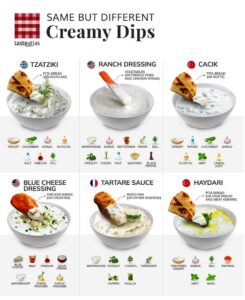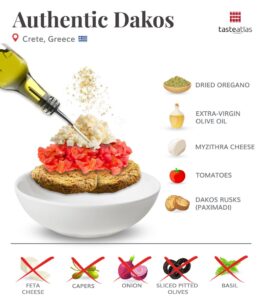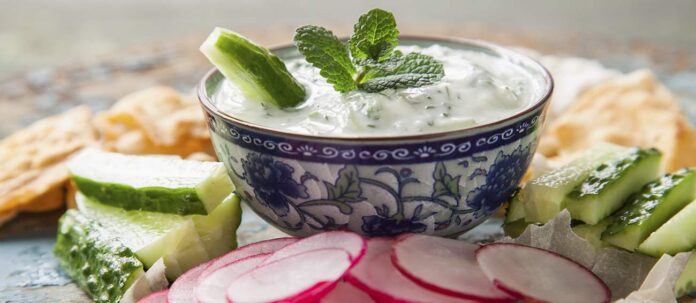The popular site Tasteatlas, has included Tzatziki and Dakos in its list. The traditional greek creamy dip Tzatziki is on the top of the six most famous tops with other dips from USA, France and Turkey!
In other article, Tasteatlas refers to the authentic Dakos as follows: is not made with Feta cheese, which is usually reserved for tourist restaurants, but with Myzithra. Also, no onion and herbs other than oregano. Capers are often added but not authentic.

What is your favorite creamy dip? What do you serve it with?
Tzatziki – (τζατζίκι, Tsatsiki)
Tzatziki is a Greek concoction made from yogurt, cucumbers, garlic, and numerous herbs and spices such as dill, mint, or parsley. It is usually served as a sauce accompanying many meat dishes, as a simple dip, or an appetizer. Its name is derived from the Turkish word cacik, denoting a very similar dip, although some suspect that tzatziki was derived from the Indian raita dip.
Tzatziki is always served cold, and it is especially popular to serve it with dishes such as gyros and souvlaki. Often, it is served with pita bread as part of the first course of a big meal. With its huge popularity, and the fact that it is one of the best summer dips, it is not strange that there are many regional variations of tzatziki, in countries such as Iran, Iraq, Turkey, Cyprus, Bulgaria, and Serbia.
The next favorite creamy dips are Ranch Dressing (USA), Cacık(Turkey), Blue Cheese Dressing (USA), Sauce tartar (France) and Haydari (Turkey).

Dakos – (Ντάκος, Koukouvagia, Kouloukopsomo, Ntakos)
Dakos or ntakos is a traditional Cretan dish consisting of a dry barley rusk called paximadi that is topped with crumbled myzithra cheese, chopped ripe tomatoes, whole olives, capers, fresh oregano, and a few generous splashes of high-quality olive oil.
It’s recommended to use olive varieties such as Koroneiki, Lianes, or Tsounates. Myzithra cheese is traditionally used, and not feta, which is usually reserved for tourist restaurants. The rusk is often gently rubbed with a small piece of garlic and lightly sprinkled with sea salt.
If available, kritamo (sea fennel) is also sometimes added to dakos. The dish is usually served as a meze or light dinner.














